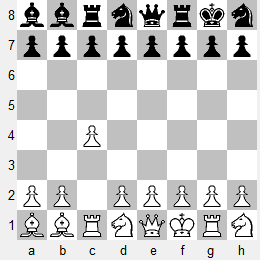In my game with White, I opened 1.c4 and my opponent played 1...O-O, reaching the position shown in the diagram. In the 'Too Soon' post, I pointed out the disadvantages of premature castling:-
- It's primarily a defensive move, which renders it somewhat passive, and
- it fixes the position of the King as a target for the opponent's pieces.
Both drawbacks apply here as well, to an even greater degree than that first example.

After 1.c4 O-O
In the current game, 1...O-O practically grants an extra tempo for development to White. Even worse, the castled King is under the gun of the Bishops which are well coordinated on adjacent diagonals. The game continued 2.b3 e5, where Black's second move also looks like a positional mistake. After an inevitable ...c5, the square d5 will be permanently weak.
I followed a simple attacking plan of Nh1-g3-f5, g2-g4, f2-f3, and Qe1-h4, eventually checkmating the Black King with 12.Qh7+. My game with the Black pieces isn't finished yet, but it has followed a similar course. White played 1.O-O and the White King was under attack before I had even played my first move.

No comments:
Post a Comment